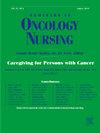通过全球营养不良领导倡议(GLIM)标准诊断的营养不良-与临床结果和预测价值的关联:系统评价的系统评价。
IF 2.3
4区 医学
Q1 NURSING
引用次数: 0
摘要
目的:营养不良在癌症患者中很常见。全球营养不良领导倡议(GLIM)关于标准的建议已被提议作为诊断营养不良的金标准。营养不良的诊断包括表型标准,如意外体重减轻和病因标准,如食物摄入量减少。这篇综述的目的是总结格雷姆定义的营养不良与临床结果的关联及其预测价值的证据。方法:系统检索PubMed、CINAHL和MEDLINE数据库。共有6篇系统综述进行了meta分析和不进行meta分析,并纳入分析。其中5篇是包含meta分析的系统综述,1篇是不包含meta分析的系统综述。结果:gim定义的营养不良与生存率降低、无病生存率、术后并发症增加、总并发症增加和住院时间延长有关。对临床预后恶化有预测价值。结论:该结果支持GLIM标准的使用,并表明其对临床结果的预测价值。有强有力的证据表明,由gim定义的营养不良与癌症患者临床结果的关联和预测价值,建议在临床实践中使用该指标。因此,GLIM标准取决于先前使用的筛选工具和肌肉质量评估的一致性。对护理实践的影响:营养护理是癌症护理实践的一个基本方面,护士需要意识到营养不良的迹象。GLIM标准也适用于癌症护理实践,用于癌症患者营养不良的早期检测。本文章由计算机程序翻译,如有差异,请以英文原文为准。
Malnutrition Diagnosed via Global Leadership Initiative on Malnutrition (GLIM) Criteria – Association with Clinical Outcomes and Predictive Value: A Systematic Review of Systematic Reviews
Objectives
Malnutrition is very common in people with cancer. The Global Leadership Initiative on Malnutrition (GLIM) recommendation on criteria has been proposed as a gold standard for diagnosing malnutrition. The diagnosis of malnutrition includes phenotypic criteria such as unintentional weight loss and etiologic criteria such as reduced food intake. The aim of this review is to summarise the evidence on the GLIM-defined malnutrition association with clinical outcomes and its predictive value.
Methods
A systematic search was conducted in PubMed, CINAHL, and MEDLINE databases. A total of 6 systematic reviews with and without meta-analysis were identified and included for analysis. Five were systematic reviews with meta-analyses and 1 systematic review without meta-analysis.
Results
GLIM-defined malnutrition is associated with decreased survival, disease-free survival, increased post-operative complications, increased overall complications, and prolonged length of stay. It has predictive value for worsening clinical outcomes.
Conclusion
The results support the use of GLIM criteria and indicate their predictive value for clinical outcomes. There is robust evidence indicating the association and predictive value of GLIM-defined malnutrition for clinical outcomes in people with cancer to recommend its use in clinical practice. Thus, the GLIM criteria depend on prior screening tools used and the consistency of muscle mass assessment.
Implications for Nursing Practice
Nutrition care is a fundamental aspect of cancer nursing practice and nurses need to be aware of the signs of malnutrition. The GLIM criteria are relevant to be used also in cancer nursing practice for the early detection of malnutrition among people with cancer.
求助全文
通过发布文献求助,成功后即可免费获取论文全文。
去求助
来源期刊

Seminars in Oncology Nursing
Nursing-Oncology (nursing)
CiteScore
3.40
自引率
0.00%
发文量
68
审稿时长
45 days
期刊介绍:
Seminars in Oncology Nursing is a unique international journal published six times a year. Each issue offers a multi-faceted overview of a single cancer topic from a selection of expert review articles and disseminates oncology nursing research relevant to patient care, nursing education, management, and policy development.
 求助内容:
求助内容: 应助结果提醒方式:
应助结果提醒方式:


